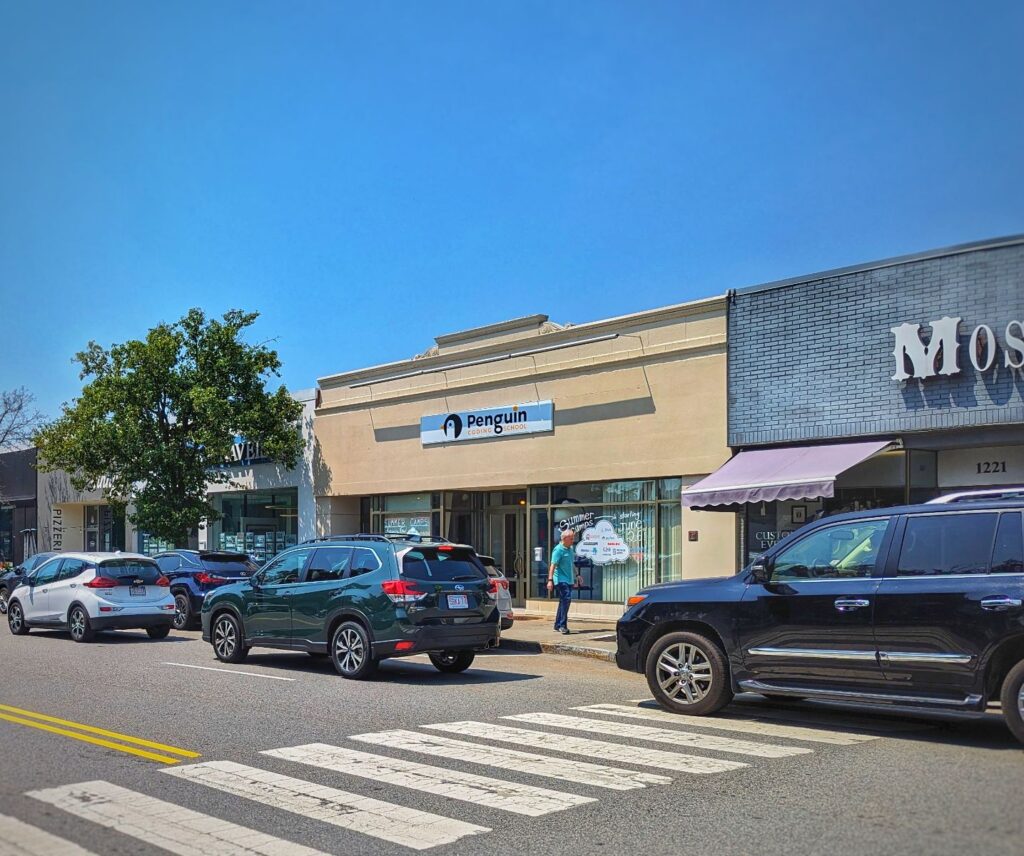ZoningPic2
Austin Street, Newton. Photo by Bryan McGonigle
Before the year is over, Newton may have a plan in place to let its village centers grow into high-density transportation hubs.
“Our village centers are tired. They’re worn,” Newton Ward 5 City Councilor Deborah Crossley, who also chairs the city’s Zoning & Planning Committee, said. “They’re not supporting the diversity of businesses they used to have.”
With a new state law requiring communities to update their zoning to allow more housing in their MBTA-served neighborhoods, Newton city officials have come up with a proposal to change the city’s decades-old zoning ordinances to let developers erect bigger buildings and more housing units with fewer parking spaces in the city’s village centers, where the city’s commuter rail and T stops sit.
“The proposal is based on a core set of goals and objectives,” Crossley said. “How well are we achieving these objectives? How well are we achieving compact development near public transit?”
That proposal, for what is being called the Village Center Overlay District, has been met with excitement and concern from residents and various local groups. And with a state deadline for new zoning approaching, the city has the task of balancing state mandates with local vision.
Legislative order, local conundrum
In 2021, the Massachusetts legislature passed a new law—the MBTA Communities Act—requiring cities and towns with MBTA access to have zoning for multi-family housing, without age restrictions, within half a mile of their MBTA stations.
It’s not optional. Communities that fail to adjust their zoning to comply with the new law could lose access to state housing grants and other funding sources.
“And then there’s the threat that the attorney general has put out there of potential lawsuits, filed by the attorney general or by others,” Newton Planning Director Barney Heath said.

This spring, Massachusetts Attorney General Andrea Joy Campbell sent cities and towns an advisory emphasizing that refusing to meet the law’s demands would be a violation of fair housing laws.
“Compliance with the MBTA Communities Zoning Law is not only mandatory, it is an essential tool for the Commonwealth to address its housing crisis along with our climate and transportation goals,” Campbell said in a statement in March. “While the housing crisis disproportionately affects communities of color and poor, working families, it threatens all of us along with our economy and thus requires all of us do our part including ensuring adequate development of affordable, transit-oriented housing for our residents and families.”
Even if Newton could afford the loss of housing and transportation grants, Crossley said, violating fair housing laws would open the city up to many more financial penalties as well as a stain on its reputation.
“Sanctions against us would be unlimited,” Crossley said. “It would be hugely embarrassing for the city of Newton not to comply.”
Compliance is complicated in Newton, which consists of about a dozen village centers rather than one downtown. And much of Newton’s village center zoning does not allow multi-family buildings with more than two units or buildings more than a couple stories tall.
And that’s where the Village Center Overlay District proposal comes in. The plan calls for zoning ordinance changes that would allow developers to build bigger buildings with more units and fewer parking spaces to comply with the new law and address housing demand.
Leveling the playing field
City officials had been discussing zoning changes for the village centers for many years. The bylaws prohibiting buildings over two stories from much of the village centers had been enacted in the 1980s, when the trend in the United States shifted more toward “downzoning” downtown business centers.
“More height was allowed earlier on, and then in ’87 was when everything was dropped pretty dramatically,” Newton Deputy Director Jennifer Caira said.
But since then, demand for more commercial and residential space has skyrocketed, but those 1980s zoning changes removed financial incentive for developers to build in Newton’s village centers.
“We did an economic analysis to try and determine what was feasible, so that if an owner wanted to redevelop a property for housing, what would they have to have to get a return,” Heath said.
That, Heath said, may be part of why Newton Centre is lined with one-story shops and not multi-story commercial and residential mixed-use buildings.

The Village Center Overlay District allows more multi-family housing, more units per building and taller buildings in the village centers by right—as opposed to special permitting—which proponents say will address Newton’s housing shortage and help bring more customers to local businesses in those village centers.
Delays brought on by the special permitting process also create more work for attorneys, whose legal services larger developers can more readily afford than their smaller competitors.
“We’re leveling the playing field a little bit, relatively,” Crossley said.
In addition to eliminating those building restrictions, the proposal calls for lowering the city’s parking requirements to allow more housing and improved sidewalks. The plan is being billed as a climate change action because it encourages less driving and more use of buses and trains.
Where things go from here
Newton is rare in that it gives its city council control of special permits. Now, the council will vote on whether or not to give up some of the power that comes with that and make permits for bigger buildings with less parking available by right as opposed to by special permit (and, by extension, City Council discretion).
Crossley said she thinks the Village Center Overlay District plan could be voted on by the Zoning & Planning Committee before the local election in November, giving the City Council time to vote on it before the Dec. 31 deadline.
“We have the votes to pass this, I believe,” Crossley said. “We certainly have a good simple majority vote.”
Whatever the City Council votes to allow, there likely won’t be an overnight redevelopment of Newton. Most of the developments currently approved in the city are outside the areas that would be affected by the new zoning. And developers would still have to go through the planning and permitting process for new construction in the village centers.
“There’s a perception that this is all going to happen at once,” Heath said. “I think people hear the number of units where there’s capacity and think, ‘Oh my goodness, that’s all going to happen here, now, in my lifetime,’ but probably not. First of all, it doesn’t work that way. And second of all, Newton’s not the only community that’s going to have zoning capacity. Brookline’s going to have zoning capacity—177 Massachusetts communities will—so demand is going to go to all sorts of places.”
In the meantime, the committee is holding public hearings online throughout the summer. And the plan to rezone the village centers is sure to be a major issue in November’s election.